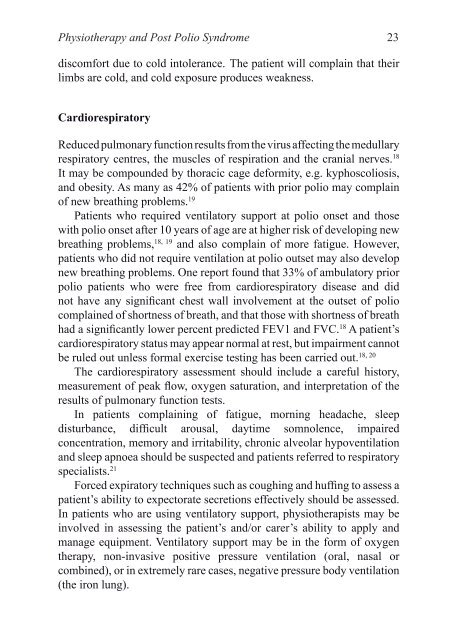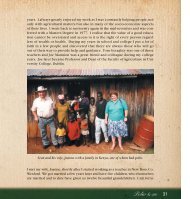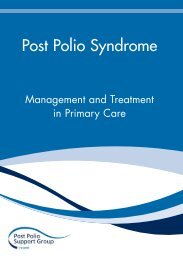Post Polio Syndrome - Management & Treatment in Primary
Post Polio Syndrome - Management & Treatment in Primary
Post Polio Syndrome - Management & Treatment in Primary
Create successful ePaper yourself
Turn your PDF publications into a flip-book with our unique Google optimized e-Paper software.
Physiotherapy and <strong>Post</strong> <strong>Polio</strong> <strong>Syndrome</strong> 23<br />
discomfort due to cold <strong>in</strong>tolerance. The patient will compla<strong>in</strong> that their<br />
limbs are cold, and cold exposure produces weakness.<br />
Cardiorespiratory<br />
Reduced pulmonary function results from the virus affect<strong>in</strong>g the medullary<br />
respiratory centres, the muscles of respiration and the cranial nerves. 18<br />
It may be compounded by thoracic cage deformity, e.g. kyphoscoliosis,<br />
and obesity. As many as 42% of patients with prior polio may compla<strong>in</strong><br />
of new breath<strong>in</strong>g problems. 19<br />
Patients who required ventilatory support at polio onset and those<br />
with polio onset after 10 years of age are at higher risk of develop<strong>in</strong>g new<br />
breath<strong>in</strong>g problems, 18, 19 and also compla<strong>in</strong> of more fatigue. However,<br />
patients who did not require ventilation at polio outset may also develop<br />
new breath<strong>in</strong>g problems. One report found that 33% of ambulatory prior<br />
polio patients who were free from cardiorespiratory disease and did<br />
not have any significant chest wall <strong>in</strong>volvement at the outset of polio<br />
compla<strong>in</strong>ed of shortness of breath, and that those with shortness of breath<br />
had a significantly lower percent predicted FEV1 and FVC. 18 A patient’s<br />
cardiorespiratory status may appear normal at rest, but impairment cannot<br />
be ruled out unless formal exercise test<strong>in</strong>g has been carried out.<br />
The cardiorespiratory assessment should <strong>in</strong>clude a careful history,<br />
measurement of peak flow, oxygen saturation, and <strong>in</strong>terpretation of the<br />
results of pulmonary function tests.<br />
In patients compla<strong>in</strong><strong>in</strong>g of fatigue, morn<strong>in</strong>g headache, sleep<br />
disturbance, difficult arousal, daytime somnolence, impaired<br />
concentration, memory and irritability, chronic alveolar hypoventilation<br />
and sleep apnoea should be suspected and patients referred to respiratory<br />
specialists. 21<br />
Forced expiratory techniques such as cough<strong>in</strong>g and huff<strong>in</strong>g to assess a<br />
patient’s ability to expectorate secretions effectively should be assessed.<br />
In patients who are us<strong>in</strong>g ventilatory support, physiotherapists may be<br />
<strong>in</strong>volved <strong>in</strong> assess<strong>in</strong>g the patient’s and/or carer’s ability to apply and<br />
manage equipment. Ventilatory support may be <strong>in</strong> the form of oxygen<br />
therapy, non-<strong>in</strong>vasive positive pressure ventilation (oral, nasal or<br />
comb<strong>in</strong>ed), or <strong>in</strong> extremely rare cases, negative pressure body ventilation<br />
(the iron lung).<br />
PPS Mngt and Treat.<strong>in</strong>db 23 02/07/2007 16:07:50<br />
18, 20





